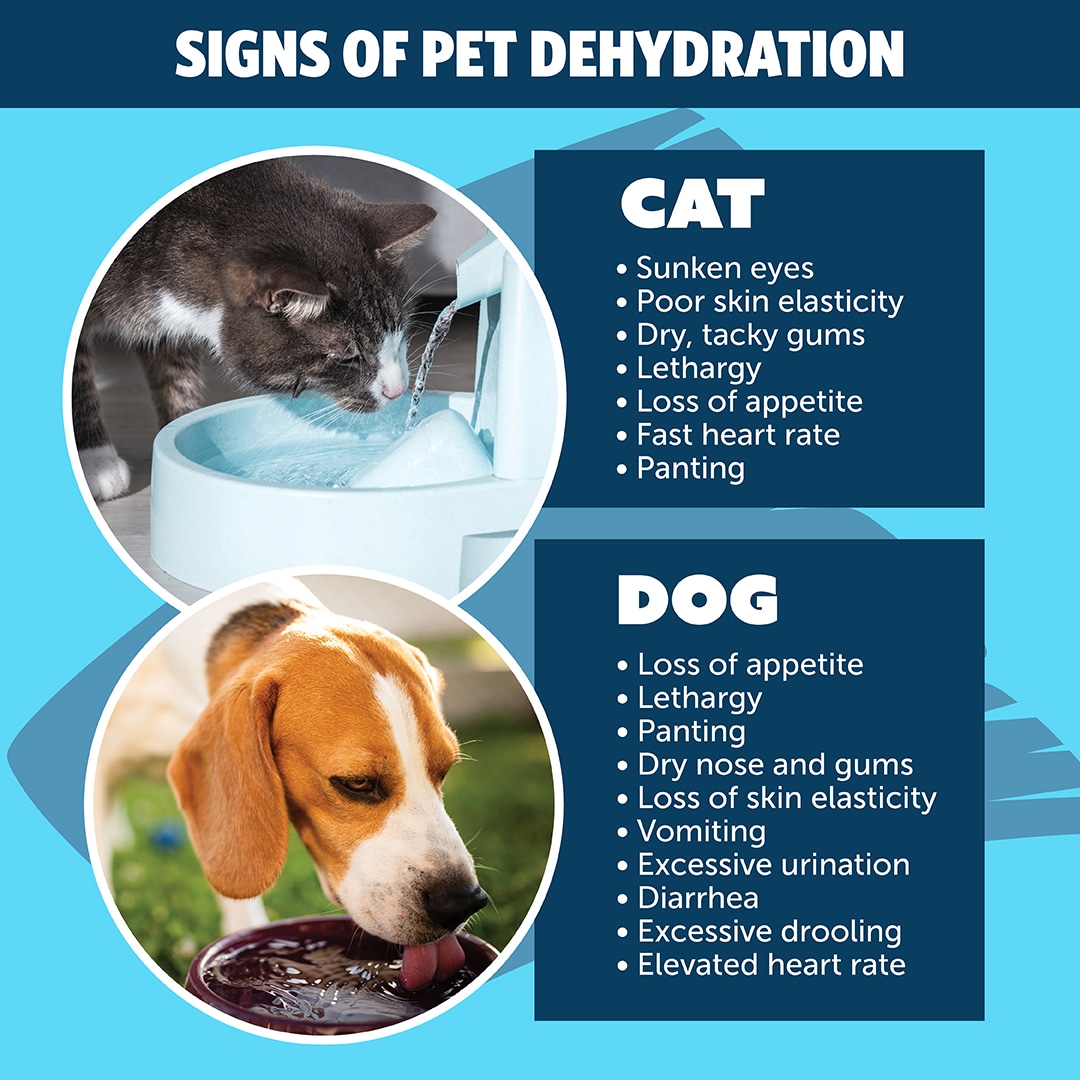It’s that time of year folks! Summer is officially here and with it comes the long, hot days and cool nights. While you’re out there enjoying the warm sun rays and cool ocean waves don’t forget about your furry friends too.
Just like humans, over 70% of your pets body is made of water. It is essential for all of their bodily functions, including: circulation, electrolyte balance, digestion, metabolism, organ function, and waste removal.
Dehydration occurs when the body loses more fluid than it’s taking in. Dehydration is always a concern for pets and humans alike, but pets – especially those spending time outdoors or in a hot indoor environment – are at a higher risk of dehydrating during the warm summer months. Regardless of where you may live, once temperatures start reaching over 85 degrees Fahrenheit, dogs, are at risk for heat stroke. Although easily prevented and resolved, dehydration in pets can cause permanent organ damage and even be life-threatening if it goes unchecked.
In general, pets become dehydrated for two reasons: reduced water intake and fluid loss. Pets sometimes drink less water due to limited access or as a result of diseases that cause them to drink less (pancreatitis, parvo, or leptospirosis). Sometimes, pets stop drinking due to stress (fireworks, guests, etc). Pets can lose excessive amounts of fluid due to heatstroke, vomiting, diarrhea, gastrointestinal disease, urinary tract conditions, endocrine disorders, kidney failure, and cancer. Puppies, kittens, pregnant pets, senior pets, and pets suffering from the above-listed medical conditions are at an increased risk of dehydration.
Another major cause of reduced fluid intake in pets is lack of hydration due to consuming low moisture (dry) food, also known as kibble. The moisture density of kibble is around 10% and canned is usually in the 50%-70% range. Without drinking copious amounts of water, kibble and many canned foods lack adequate moisture to keep pets sufficiently hydrated.
Coupled with the various reasons pets may refuse to drink water, including not regularly refilling water dishes, whiskers touching the sides of the bowl, or high mineral content in tap water, switching to a high moisture food is a major solution to pet dehydration. Cats, both domestic and wild, have a low thirst drive preferring to get their water from the food they eat rather than drinking from a water dish. That being said, some cats tend to increase their fluid intake when drinking from a running water sources such as a pet fountain or sink. The bottom line is it’s tough to get a cat or dog to drink when they don’t want to.
Signs and Symptoms of pet dehydration are as follows:
One simple way to determine if a pet is dehydrated is to pinch the loose skin between the shoulder blades. If the skin stays put or is slow to return to its normal position, then your pet is likely dehydrated. If your pet is dehydrated, provide them with cool drinking water and contact your emergency veterinarian right away. Dehydrated pets often require medical attention to replenish their fluids and restore the balance of electrolytes in their system, usually intravenously.
To prevent dehydration, try some of the tips provided earlier in this article. Regularly change your pets water with fresh, clean water in a clean bowl. Also, switching your pet from a dry kibble or highly processed commercial food to food with a high intercellular moisture content and limited ingredients.
All of Fetching Foods meals are approximately 75% moisture. The food is naturally loaded with intercellular moisture which is very efficient at hydrating cats and dogs. A moisture rich food is the best way to ensure your pet has a good baseline level of hydration. You can boost the moisture content like we do for our babies by adding a little water and/or our broth to the food before serving.
Some dog owners try flavoring water with bone broth or giving their dogs ice cubes to chew on. Fetching Foods Broth products can be added to your pets food or water to increase hydration by providing a tasty alternative to plain water or dry kibble. This product can be given as a treat by freezing in ice cube trays then serve on a hot summer day like a popsicle! Cats love the broths too!
We hope you have a fantastic summer where your fur babies live their best lives in the healthiest way.

In recent years, pet owners have become increasingly concerned about the quality and nutritional value of the food they feed their furry companions. One trend that has been gaining popularity is the use of hydrolyzed ...
Introduction As pet owners, we are constantly seeking ways to improve the health and well-being of our beloved furry companions. One aspect that has gained significant attention in recent years is the use of herbal ...
As we move through this holiday season and towards the new year, we’ve been stuffing our faces as we prepare to stuff our stockings! You might already be at the point where you are loosening ...